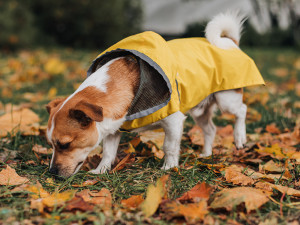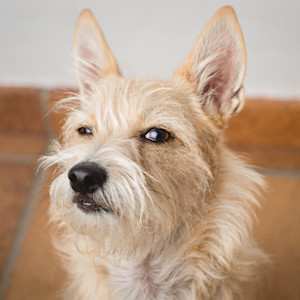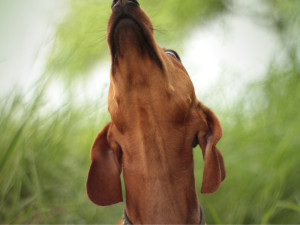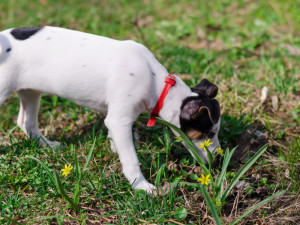
Share Article
In This Article:
Why Do Dogs Sniff Everything? Why Do Dogs Sniff Other Dog’s Butts? Why Do Dogs Sniff Your Butt? What A Dog’s Sense of Smell Reveals
If you’ve ever taken your dog to a daycare or dog park, you’ve probably noticed their first order of business is to sniff other dogs’ butts. Sure, they may be saying “hello,” but does it have to be so… invasive?
As weird as it may look to the human eye, butt-sniffing is actually a healthy, normal behavior for dogs. And if the dogs engaged in the behavior are supervised and properly socialized (as well as off-leash), letting pups sniff each other out can actually be a good thing. Dogs who get to know each other are less likely to fight, and a thorough butt sniff can offer all the information your pup needs to make a new friend.
“Dogs primarily gather information about the world by sniffing (unlike humans who rely on sight and sound, so out of all of their senses, [smell] is probably the most important for how they learn to recognize and interpret the world around them,” Alexandra Bassett, dog trainer and behavior consultant at Dog Savvy LAopens in new tab, says. “Their sense of smell is so powerful that it can detect scents that are hours or even days old, plus they can track scents over long distances.”
How much do you spend on your pet per year?

Why do dogs sniff everything?
A dog’s olfactory system is incredibly advanced, especially compared to humansopens in new tab. For context, humans have about six million olfactory receptors in their noses, which may sound like a lot, but dogs can have up to 300 million.
“Their sense of smell can help them identify and track specific individuals, including their owners, family members, and other dogs, as well as changes in scent related to illness or stress,” Bassett says. “A dog’s sense of smell is also closely linked to their brain’s emotional and memory centers, which means that smells can evoke strong emotional responses and memories in dogs.”
Your pup can even smell scents layered on top of each otheropens in new tab, picking up information in places where we can’t smell anything. But sniffing isn’t just about learning about the world around them, although that’s a big piece. Dogs also use their noses to navigate their surroundings simply because sniffing is enjoyable for themopens in new tab.
Why do dogs sniff other dogs’ butts?
Why do dogs smell each other? This behavior is often seen as a greeting, but it’s way more than a simple hello. Research suggests that a dog’s brain may process smells in a similar way to how the human brain processes sights.
Every animal (humans included) has their own unique scent, and dogs can learn a ton about others through these smells — as well as other behaviors, l ike licking. These identifying scents just happen to be more potent around the anus. Through a thorough butt sniff, dogs can learn about the healthopens in new tab and even temperament of other dogs. That’s a lot of information located back there!
“Dogs sniff other dogs’ butts as a way of gathering information about each other,” Bassett says. “Dogs have two small, oval-shaped sacs on either side of their anus called anal glands. These glands produce a fluid with a very strong smell that is unique to each dog and believed to emit pheromones — chemical signals that convey information about an individual dog’s identity, sex, reproductive status, and emotional state.”
Why do dogs sniff your butt?
Sniffing other dogs’ butts is one thing, but why do dogs sniff you? Dogs have a tendency to go straight for human butts and crotches, much to everyone’s embarrassment, but they’re just drawn to the smells emanating from this area. Just like dogs, humans release unique, identifying scents.
“It’s essential to remember that dogs are wired to follow their noses, and sniffing is a natural behavior for them,” Bassett says. “Human mouths, groins, and butts emit strong scents, which is why dogs instantly gravitate to them. While it may not be the most polite or socially acceptable behavior, it’s not necessarily a cause for concern.”
Dogs may sniff their human parents’ butts simply because they love you. Canines stay connected to other dogs by exchanging smells, and sniffing their human mom or dad is a way of expressing their closeness to you. If you’ve been out of the house, they could also use their powerful noses to figure outopens in new tab where you’ve been, who you’ve seen, and what you’ve eaten. Research has even found dogs can tell their humans’ emotional states or whether they’re illopens in new tab through smell.
While crotch- and butt-sniffing is just part of a dog’s nature, it’s okay to discourage this behavior to avoid awkward interactions. Try redirecting your pup to another activity.
What a dog’s sense of smell reveals
While we tend to use our vision to make sense of our surroundings, dogs rely more heavily on their sense of smellopens in new tab. By sniffing another dog’s rear end, your pup can pick up on detailed informationopens in new tab, like the other animal’s age, health status, and diet. They can even determine if the other dog is illopens in new tab, as well as pick up on their mood. Each dog (and person) has a unique scent that can help your dog “recognize” animals they’ve met before.
Dogs may also sniff each other’s butts to establish social structure. When two dogs meet each other, they will likely investigate via smell to learn more about who the other dog is. The dog who sniffs first may even be considered dominant in the interaction.
Why dogs sniff butts can also be related to pheromones. Canine anal glands contain pheromones that can reveal information about a dog’s identity to other dogs. Dogs can learn about another’s diet, health, age, gender, and even mood through these scents. A dog’s powerful sense of smell gives them context about other dogs (and people) they meet. They can even tell how old a smell isopens in new tab to see how recently a dog has been in the area.
References
Bucher, Steve. “Dogs Smell Cancer? The Canine Nose Sniffs Out New Methods in Cancer Detection Technology.” USC Viterbi School of Engineering, 3 July 2024, illumin.usc.edu/dogs-smell-cancer-the-canine-nose-sniffs-out-new-methods-in-cancer-detection-technologyopens in new tab.
“Dogs Smell Time.” Exploratorium, 19 June 2014, www.exploratorium.edu/blogs/spectrum/dogs-smell-timeopens in new tab.
Graham, Daniel. “Do Dogs ‘See’ Smell?” Hobart and William Smith, 10 Nov. 2022, www.hws.edu/news/2022/do-dogs-see-smell.aspxopens in new tab.
Hayes, Caitlin. “Study Finds New Links Between Dogs’ Smell and Vision.” Cornell Chronicle, 18 July 2022, news.cornell.edu/stories/2022/07/study-finds-new-links-between-dogs-smell-and-visionopens in new tab.
Kelley, Mackenzie. “Human-Animal Communication in Captive Species: Dogs, Horses, and Whales.” JMU Scholarly Commons, 2015, commons.lib.jmu.edu/cgi/viewcontent.cgi?article=1113&context=honors201019opens in new tab.
Kokocinska, Agata, et al. “Canine Smell Preferences—Do Dogs Have Their Favorite Scents?” Animals, vol. 12, no. 12, June 2022, p. 1488, https://doi.org/10.3390/ani12121488opens in new tab.
Kokocinska-Kusiak, Agata, et al. “Canine Olfaction: Physiology, Behavior, and Possibilities for Practical Applications.” Animals, vol. 11, no. 8, Aug. 2021, p. 2463. https://doi.org/10.3390/ani11082463opens in new tab.
Moffitt, Seth. “Research Suggests Dogs Can Be Trained to Sniff Out Cancer in Other Dogs.” School of Veterinary Medicine, 20 Dec. 2023, www.vetmed.wisc.edu/research-suggests-dogs-can-be-trained-to-sniff-out-cancer-in-other-dogsopens in new tab.
Rozell, Ned. “A Nose 1,000 Times Better Than Ours.” UAF News and Information, 29 Sept. 2023, www.uaf.edu/news/a-nose/1000-times-better–than-ours.phpopens in new tab.
Rozell, Ned. “The World According to a Dog’s Nose.” UAF News and Information, 8 June 2022, www.uaf.edu/news/the-world-according-to-a-dogs-nose.phpopens in new tab.
Salustri, David. “K-9 Behaviors | What Your Dog’s Behaviors Mean | K-9 Mysteries.” Community Care College, 24 Feb. 2023, communitycarecollege.edu/veterinary-assistant/pet-behavior/k-9-behaviorsopens in new tab.
Tachibana, Chris. “Probing Question: Can Dogs Smell Disease in Humans?” Penn State University, 12 April 2010, www.psu.edu/news/research/story/probing-question-can-dogs-smell-disease-humansopens in new tab.
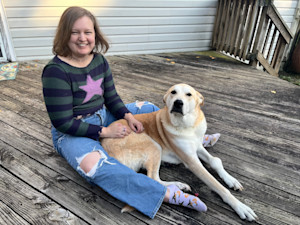
Savannah Admire
Savannah Admire is a writer and pet mom to two dogs and a cat. Under the name Savannah Cooper, she has published poetry in 40 different publications, as well as a poetry book, Mother Viper (2025). When she’s not writing, you can find her reading, taking photos, or volunteering as a content creator for her local community theatre. As a pets writer, she focuses on cat and dog behavior and pet parenthood. She currently lives in Western Maryland.
Related articles
![Close up shot of a brown dog sniffing upward out of frame with blurry grass in background]()
Crotch Sniffing: Crude or Customary?
Is it time to teach your dog some boundaries?
![A little puppy Jack Russell terrier is smelling the grass in the park with red dog-collar.]()
On Your Next Walk, Let Your Pup Follow Their Nose
A “sniffari” gives your dog a chance to be the boss.
Why Are Dogs Obsessed With Sniffing the Snow?
And why you deserve a pat on the back for indulging them.
![weird dog rolling in poop]()
7 Weird Dog Behaviors Explained
Chasing their tails, eating grass, and rolling in garbage — should you worry?
![Woman and dog in lavender field.]()
Dogs Have Favorite Scents, Study Says—And No, It’s Not Just the Smell of Food
So, go ahead and get that lavender-scented candle.
Dog Senses: What Are Dogs’ Strongest Senses?
That little nose sure works well...
